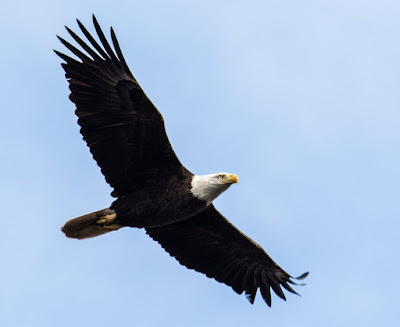Marvels of the Bald Eagle
As most people probably know, the bald eagle is the national symbol and official bird of these here United States, although its range covers Canada, the US, and down Mexico way somewhat. Although "bald" means "hairless" nowadays, the scientific name, Haliaeetus leucocephalus, has "leukos", back when "bald" meant "white". That there is a bonus fun fact at no extra charge. You're welcome. Impress your friends, but I'd skip trying to pronounce the Latin part.
Birds are amazing creatures that exhibit the skills of the Master Engineer, and their intricacy defies evolutionary storytelling. (People who claim that dinosaurs evolved into birds don't seem to know basic ornithology. Darwinists have no real idea when eagles first appeared in the fossil record.) Eagles have exceptionally sharp vision, and are designed for high-speed power dives as well as conserving energy riding the updrafts.
Nesting areas are usually selected so they can do their hunting. They are skilled at hunting fish, but are not too proud to eat carrion, my wayward son. In many ways, the eagle is a marvel of design, beauty, grace, and creativity. No wonder the Bible mentions them several times.
 |
| Credit: Pixabay / Dave_E |
Nesting areas are usually selected so they can do their hunting. They are skilled at hunting fish, but are not too proud to eat carrion, my wayward son. In many ways, the eagle is a marvel of design, beauty, grace, and creativity. No wonder the Bible mentions them several times.
The bald eagle is indigenous to North America and can be found near any kind of wetland habitat or large body of open water where there is an abundant supply of fish. Bald eagles mate for life and build large eyries or nests, typically within 200 m (700 ft) of their chosen water source, though they can be as far as 3 km (2 miles) away. Good nesting trees usually have the following characteristics: height (to provide protection for eggs and young eaglets); visibility of the major food source (the body of water); and sparse foliage (allowing for an open flight path to and from the nest). While eyries are typically placed 15–40 m (50–130 ft) above ground, they can be positioned much lower wherae trees stand in water (such as mangroves), or even on the ground. They are the largest tree nests recorded for any animal species: up to 6 m (20 ft) deep, 3 m (10 ft) wide and weighing more than 2 tonnes (4,500 lb).To read the article in its entirety, glide on over to "The American bald eagle: On eagle’s wings".